This post is an abridged online version of my article that appears in Galilean Electrodynamics in November, 2008. [Ref: Galilean Electrodynamics, Vol. 19, No. 6, Nov/Dec 2008, pp: 103–117] ()
Cognitive neuroscience treats space and time as our brain’s representation of our sensory inputs. In this view, our perceptual reality is only a distant and convenient mapping of the physical processes causing the sensory inputs. Sound is a mapping of auditory inputs, and space is a representation of visual inputs. Any limitation in the chain of sensing has a specific manifestation on the cognitive representation that is our reality. One physical limitation of our visual sensing is the finite speed of light, which manifests itself as a basic property of our space-time. In this article, we look at the consequences of the limited speed of our perception, namely the speed of light, and show that they are remarkably similar to the coordinate transformation in special relativity. From this observation, and inspired by the notion that space is merely a cognitive model created out of light signal inputs, we examine the implications of treating special relativity theory as a formalism for describing the perceptual effects due to the finite speed of light. Using this framework, we show that we can unify and explain a wide array of seemingly unrelated astrophysical and cosmological phenomena. Once we identify the manifestations of the limitations in our perception and cognitive representation, we can understand the consequent constraints on our space and time, leading to a new understanding of astrophysics and cosmology.
Key words: cognitive neuroscience; reality; special relativity; light travel time effect; gamma rays bursts; cosmic microwave background radiation.
1. Introduction
Our reality is a mental picture that our brain creates, starting from our sensory inputs [1]. Although this cognitive map is often assumed to be a faithful image of the physical causes behind the sensing process, the causes themselves are entirely different from the perceptual experience of sensing. The difference between the cognitive representation and their physical causes is not immediately obvious when we consider our primary sense of sight. But, we can appreciate the difference by looking at the olfactory and auditory senses because we can use our cognitive model based on sight in order to understand the workings of the ‘lesser’ senses. Odors, which may appear to be a property of the air we breathe, are in fact our brain’s representation of the chemical signatures that our noses sense. Similarly, sound is not an intrinsic property of a vibrating body, but our brain’s mechanism to represent the pressure waves in the air that our ears sense. Table I shows the chain from the physical causes of the sensory input to the final reality as the brain creates it. Although the physical causes can be identified for the olfactory and auditory chains, they are not easily discerned for visual process. Since sight is the most powerful sense we possess, we are obliged to accept our brain’s representation of visual inputs as the fundamental reality.
While our visual reality provides an excellent framework for physical sciences, it is important to realize that the reality itself is a model with potential physical or physiological limitations and distortions. The tight integration between the physiology of perception and its representation in the brain was proven recently in a clever experiment using the tactile funneling illusion [2]. This illusion results in a single tactile sensation at the focal point at the center of a stimulus pattern even though no stimulation is applied at that site. In the experiment, the brain activation region corresponded to the focal point where the sensation was perceived, rather than the points where the stimuli were applied, proving that the brain registered perceptions, not the physical causes of the perceived reality. In other words, for the brain, there is no difference between applying the pattern of the stimuli and applying only one stimulus at the center of the pattern. The brain maps the sensory inputs to regions that correspond to their perception, rather than the regions that physiologically correspond to the sensory stimuli.
| Sense modality:
|
Physical cause:
|
Sensed signal:
|
Brain’s model:
|
|
Olfactory
|
Chemicals
|
Chemical reactions
|
Smells
|
|
Auditory
|
Vibrations
|
Pressure waves
|
Sounds
|
|
Visual
|
Unknown
|
Light |
Space, time
reality |
Table I: The brain’s representation of different sensory inputs. Odors are a representation of chemical compositions and concentration our nose senses. Sounds are a mapping of the air pressure waves produced by a vibrating object. In sight, we do not know the physical reality, our representation is space, and possibly time.
The neurological localization of different aspects of reality has been established in neuroscience by lesion studies. The perception of motion (and the consequent basis of our sense of time), for instance, is so localized that a tiny lesion can erase it completely. Cases of patients with such specific loss of a part of reality [1] illustrate the fact that our experience of reality, every aspect of it, is indeed a creation of the brain. Space and time are aspects of the cognitive representation in our brain.
Space is a perceptual experience much like sound. Comparisons between the auditory and visual modes of sensing can be useful in understanding the limitations of their representations in the brain. One limitation is the input ranges of the sensory organs. Ears are sensitive in the frequency range 20Hz-20kHz, and eyes are limited to the visible spectrum. Another limitation, which may exist in specific individuals, is an inadequate representation of the inputs. Such a limitation can lead to tone-deafness and color-blindness, for instance. The speed of the sense modality also introduces an effect, such as the time lag between seeing an event and hearing the corresponding sound. For visual perception, a consequence of the finite speed of light is called a Light Travel Time (LTT) effect. LLT offers one possible interpretation for the observed superluminal motion in certain celestial objects [3,4]: when an object approaches the observer at a shallow angle, it may appear to move much faster than reality [5] due to LTT.
Other consequences of the LTT effects in our perception are remarkably similar to the coordinate transformation of the special relativity theory (SRT). These consequences include an apparent contraction of a receding object along its direction of motion and a time dilation effect. Furthermore, a receding object can never appear to be going faster than the speed of light, even if its real speed is superluminal. While SRT does not explicitly forbid it, superluminality is understood to lead to time travel and the consequent violations of causality. An apparent violation of causality is one of the consequences of LTT, when the superluminal object is approaching the observer. All these LTT effects are remarkably similar to effects predicted by SRT, and are currently taken as ‘confirmation’ that space-time obeys SRT. But instead, space-time may have a deeper structure that, when filtered through LTT effects, results in our perception that space-time obeys SRT.
Once we accept the neuroscience view of reality as a representation of our sensory inputs, we can understand why the speed of light figures so prominently in our physical theories. The theories of physics are a description of reality. Reality is created out of the readings from our senses, especially our eyes. They work at the speed of light. Thus the sanctity accorded to the speed of light is a feature only of our reality, not the absolute, ultimate reality that our senses are striving to perceive. When it comes to physics that describes phenomena well beyond our sensory ranges, we really have to take into account the role that our perception and cognition play in seeing them. The Universe as we see it is only a cognitive model created out of the photons falling on our retina or on the photo-sensors of the Hubble telescope. Because of the finite speed of the information carrier (namely photons), our perception is distorted in such a way as to give us the impression that space and time obey SRT. They do, but space and time are not the absolute reality. “Space and time are modes by which we think and not conditions in which we live,” as Einstein himself put it. Treating our perceived reality as our brain’s representation of our visual inputs (filtered through the LTT effect), we will see that all the strange effects of the coordinate transformation in SRT can be understood as the manifestations of the finite speed of our senses in our space and time.
Furthermore, we will show that this line of thinking leads to natural explanations for two classes of astrophysical phenomena:
Gamma Ray Bursts, which are very brief, but intense flashes of  rays, currently believed to emanate from cataclysmic stellar collapses, and Radio Sources, which are typically symmetric and seem associated with galactic cores, currently considered manifestations of space-time singularities or neutron stars. These two astrophysical phenomena appear distinct and unrelated, but they can be unified and explained using LTT effects. This article presents such a unified quantitative model. It will also show that the cognitive limitations to reality due to LTT effects can provide qualitative explanations for such cosmological features as the apparent expansion of the Universe and the Cosmic Microwave Background Radiation (CMBR). Both these phenomena can be understood as related to our perception of superluminal objects. It is the unification of these seemingly distinct phenomena at vastly different length and time scales, along with its conceptual simplicity, that we hold as the indicators of validity of this framework.
rays, currently believed to emanate from cataclysmic stellar collapses, and Radio Sources, which are typically symmetric and seem associated with galactic cores, currently considered manifestations of space-time singularities or neutron stars. These two astrophysical phenomena appear distinct and unrelated, but they can be unified and explained using LTT effects. This article presents such a unified quantitative model. It will also show that the cognitive limitations to reality due to LTT effects can provide qualitative explanations for such cosmological features as the apparent expansion of the Universe and the Cosmic Microwave Background Radiation (CMBR). Both these phenomena can be understood as related to our perception of superluminal objects. It is the unification of these seemingly distinct phenomena at vastly different length and time scales, along with its conceptual simplicity, that we hold as the indicators of validity of this framework.
2. Similarities between LTT Effects & SRT
The coordinate transformation derived in Einstein’s original paper [6] is, in part, a manifestation of the LTT effects and the consequence of imposing the constancy of light speed in all inertial frames. This is most obvious in the first thought experiment, where observers moving with a rod find their clocks not synchronized due to the difference in LTT’s along the length of the rod. However, in the current interpretation of SRT, the coordinate transformation is considered a basic property of space and time. One difficulty that arises from this formulation is that the definition of the relative velocity between the two inertial frames becomes ambiguous. If it is the velocity of the moving frame as measured by the observer, then the observed superluminal motion in radio jets starting from the core region becomes a violation of SRT. If it is a velocity that we have to deduce by considering LTT effects, then we have to employ the extra ad-hoc assumption that superluminality is forbidden. These difficulties suggest that it may be better to disentangle the LTT effects from the rest of SRT. Although not attempted in this paper, the primary motivation for SRT, namely the covariance of Maxwell’s equations, may be accomplished even without attributing LTT effects to the properties of space and time.
In this Section, we will consider space and time as a part of the cognitive model created by the brain, and illustrate that SRT applies to the cognitive model. The absolute reality (of which the SRT-like space-time is our perception) does not have to obey the restrictions of SRT. In particular, objects are not restricted to subluminal speeds, even though they may appear to us as if they are restricted to subluminal speeds in our perception of space and time. If we disentangle LTT effects from the rest of SRT, we can understand a wide array of phenomena, as shown in this article.
SRT seeks a linear coordinate transformation between coordinate systems in motion with respect to each other. We can trace the origin of linearity to a hidden assumption on the nature of space and time built into SRT, as stated by Einstein [6]: “In the first place it is clear that the equations must be linear on account of the properties of homogeneity which we attribute to space and time.” Because of this assumption of linearity, the original derivation of the transformation equations ignores the asymmetry between approaching and receding objects and concentrates on receding objects. Both approaching and receding objects can be described by two coordinate systems that are always receding from each other. For instance, if a system K is moving with respect to another system k along the positive X axis of k, then an object at rest in K at a positive x is approaching an observer at the origin of k. Unlike SRT, considerations based on LTT effects result in intrinsically different set of transformation laws for objects approaching an observer and those receding from him. More generally, the transformation depends on the angle between the velocity of the object and the observer’s line of sight. Since the transformation equations based on LTT effects treat approaching and receding objects asymmetrically, they provide a natural solution to the twin paradox, for instance.
2.1 First Order Perceptual Effects
For approaching and receding objects, the relativistic effects are second order in speed  , and speed typically appears as
, and speed typically appears as  . The LTT effects, on the other hand, are first order in speed. The first order effects have been studied in the last fifty years in terms of the appearance of a relativistically moving extended body [7-15]. It has also been suggested that the relativistic Doppler effect can be considered the geometric mean [16] of more basic calculations. The current belief is that the first order effects are an optical illusion to be taken out of our perception of reality. Once these effects are taken out or ‘deconvolved’ from the observations, the ‘real’ space and time are assumed to obey SRT. Note that this assumption is impossible to verify because the deconvolution is an ill-posed problem – there are multiple solutions to the absolute reality that all result in the same perceptual picture. Not all the solutions obey SRT.
. The LTT effects, on the other hand, are first order in speed. The first order effects have been studied in the last fifty years in terms of the appearance of a relativistically moving extended body [7-15]. It has also been suggested that the relativistic Doppler effect can be considered the geometric mean [16] of more basic calculations. The current belief is that the first order effects are an optical illusion to be taken out of our perception of reality. Once these effects are taken out or ‘deconvolved’ from the observations, the ‘real’ space and time are assumed to obey SRT. Note that this assumption is impossible to verify because the deconvolution is an ill-posed problem – there are multiple solutions to the absolute reality that all result in the same perceptual picture. Not all the solutions obey SRT.
The notion that it is the absolute reality that obeys SRT ushers in a deeper philosophical problem. This notion is tantamount to insisting that space and time are in fact ‘intuitions’ beyond sensory perception rather than a cognitive picture created by our brain out of the sensory inputs it receives. A formal critique of the Kantian intuitions of space and time is beyond the scope of this article. Here, we take the position that it is our observed or perceived reality that obeys SRT and explore where it leads us. In other words, we assume that SRT is nothing but a formalization of the perceptual effects. These effects are not first order in speed when the object is not directly approaching (or receding from) the observer, as we will see later. We will show in this article that a treatment of SRT as a perceptual effect will give us natural solution for astrophysical phenomena like gamma ray bursts and symmetric radio jets.
2.2 Perception of Speed
We first look at how the perception of motion is modulated by LTT effects. As remarked earlier, the transformation equations of SRT treat only objects receding from the observer. For this reason, we first consider a receding object, flying away from the observer at a speed  of the object depends on the real speed b (as shown in Appendix A.1):
of the object depends on the real speed b (as shown in Appendix A.1):
 (1)
(1)
 (2)
(2)
Thus, due to LTT effects, an infinite real velocity gets mapped to an apparent velocity

. In other words, no object can
appear to travel faster than the speed of light, entirely consistent with SRT.
Physically, this apparent speed limit amounts to a mapping of  to
to  . This mapping is most obvious in its consequences. For instance, it takes an infinite amount of energy to accelerate an object to an apparent speed
. This mapping is most obvious in its consequences. For instance, it takes an infinite amount of energy to accelerate an object to an apparent speed  because, in reality, we are accelerating it to an infinite speed. This infinite energy requirement can also be viewed as the relativistic mass changing with speed, reaching
because, in reality, we are accelerating it to an infinite speed. This infinite energy requirement can also be viewed as the relativistic mass changing with speed, reaching  at
at  . Einstein explained this mapping as: “For velocities greater than that of light our deliberations become meaningless; we shall, however, find in what follows, that the velocity of light in our theory plays the part, physically, of an infinitely great velocity.” Thus, for objects receding from the observer, the effects of LTT are almost identical to the consequences of SRT, in terms of the perception of speed.
. Einstein explained this mapping as: “For velocities greater than that of light our deliberations become meaningless; we shall, however, find in what follows, that the velocity of light in our theory plays the part, physically, of an infinitely great velocity.” Thus, for objects receding from the observer, the effects of LTT are almost identical to the consequences of SRT, in terms of the perception of speed.
2.3 Time Dilation
Time Dilation
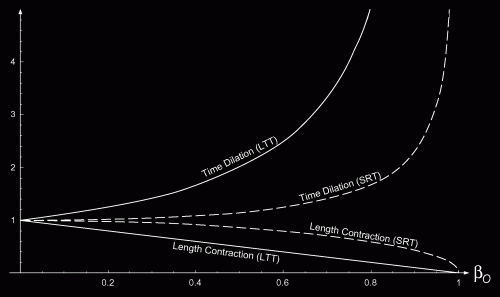 |
Figure 1:. Comparison between light travel time (LTT) effects and the predictions of the special theory of relativity (SR). The X-axis is the apparent speed and the Y-axis shows the relative time dilation or length contraction.
|
LTT effects influence the way time at the moving object is perceived. Imagine an object receding from the observer at a constant rate. As it moves away, the successive photons emitted by the object take longer and longer to reach the observer because they are emitted at farther and farther away. This travel time delay gives the observer the illusion that time is flowing slower for the moving object. It can be easily shown (see Appendix A.2) that the time interval observed  is related to the real time interval
is related to the real time interval  as:
as:
 (3)
(3)
for an object receding from the observer (

). This observed time dilation is plotted in Fig. 1, where it is compared to the time dilation predicted in SR. Note that the time dilation due to LTT has a bigger magnitude than the one predicted in SR. However, the variation is similar, with both time dilations tending to

as the observed speed tends to

.
2.4 Length Contraction
The length of an object in motion also appears different due to LTT effects. It can be shown (see Appendix A.3) that observed length  as:
as:
 (4)
(4)
for an object receding from the observer with an apparent speed of

. This equation also is plotted in Fig. 1. Note again that the LTT effects are stronger than the ones predicted in SRT.
Fig. 1 illustrates that both time dilation and Lorentz contraction can be thought of as LTT effects. While the actual magnitudes of LTT effects are larger than what SRT predicts, their qualitative dependence on speed is almost identical. This similarity is not surprising because the coordinate transformation in SRT is partly based on LTT effects. If LTT effects are to be applied, as an optical illusion, on top of the consequences of SRT as currently believed, then the total observed length contraction and time dilation will be significantly more than the SRT predictions.
2.5 Doppler Shift
The rest of the article (the sections up to Conclusions) has been abridged and can be read in the PDF version.
()
|
5 Conclusions
In this article, we started with an insight from cognitive neuroscience about the nature of reality. Reality is a convenient representation that our brain creates out of our sensory inputs. This representation, though convenient, is an incredibly distant experiential mapping of the actual physical causes that make up the inputs to our senses. Furthermore, limitations in the chain of sensing and perception map to measurable and predictable manifestations to the reality we perceive. One such fundamental constraint to our perceived reality is the speed of light, and the corresponding manifestations, LTT effects. Because space and time are a part of a reality created out of light inputs to our eyes, some of their properties are manifestations of LTT effects, especially on our perception of motion. The absolute, physical reality generating the light inputs does not obey the properties we ascribe to our perceived space and time. We showed that LTT effects are qualitatively identical to those of SRT, noting that SRT only considers frames of reference receding from each other. This similarity is not surprising because the coordinate transformation in SRT is derived based partly on LTT effects, and partly on the assumption that light travels at the same speed with respect to all inertial frames. In treating it as a manifestation of LTT, we did not address the primary motivation of SRT, which is a covariant formulation of Maxwell’s equations, as evidenced by the opening statements of Einstein’s original paper [6]. It may be possible to disentangle the covariance of electrodynamics from the coordinate transformation, although it is not attempted in this article.
Unlike SRT, LTT effects are asymmetric. This asymmetry provides a resolution to the twin paradox and an interpretation of the assumed causality violations associated with superluminality. Furthermore, the perception of superluminality is modulated by LTT effects, and explains g ray bursts and symmetric jets. As we showed in the article, perception of superluminal motion also holds an explanation for cosmological phenomena like the expansion of the Universe and cosmic microwave background radiation. LTT effects should be considered as a fundamental constraint in our perception, and consequently in physics, rather than as a convenient explanation for isolated phenomena. Given that our perception is filtered through LTT effects, we have to deconvolute them from our perceived reality in order to understand the nature of the absolute, physical reality. This deconvolution, however, results in multiple solutions. Thus, the absolute, physical reality is beyond our grasp, and any assumed properties of the absolute reality can only be validated through how well the resultant perceived reality agrees with our observations. In this article, we assumed that the absolute reality obeys our intuitively obvious classical mechanics and asked the question how such a reality would be perceived when filtered through LTT effects. We demonstrated that this particular treatment could explain certain astrophysical and cosmological phenomena that we observe. The distinction between the different notions of velocity, including the proper velocity and the Einsteinian velocity, was the subject matter of a recent issue of this journal [33].
The coordinate transformation in SRT should be viewed as a redefinition of space and time (or, more generally, reality) in order to accommodate the distortions in our perception of motion due to LTT effects. The absolute reality behind our perception is not subject to restrictions of SRT. One may be tempted to argue that SRT applies to the ‘real’ space and time, not our perception. This line of argument begs the question, what is real? Reality is nothing but a cognitive model created in our brain starting from our sensory inputs, visual inputs being the most significant. Space itself is a part of this cognitive model. The properties of space are a mapping of the constraints of our perception. We have no access to a reality beyond our perception. The choice of accepting our perception as a true image of reality and redefining space and time as described in SRT indeed amounts to a philosophical choice. The alternative presented in the article is prompted by the view in modern neuroscience that reality is a cognitive model in the brain based on our sensory inputs. Adopting this alternative reduces us to guessing the nature of the absolute reality and comparing its predicted projection to our real perception. It may simplify and elucidate some theories in physics and explain some puzzling phenomena in our Universe. However, this option is yet another philosophical stance against the unknowable absolute reality.
References
[1] V.S. Ramachandran, “The Emerging Mind: Reith Lectures on Neuroscience” (BBC, 2003).
[2] L.M. Chen, R.M. Friedman, and A. W. Roe, Science 302, 881 (2003).
[3] J.A. Biretta, W.B. Sparks, and F. Macchetto, ApJ 520, 621 (1999).
[4] A.J. Zensus, ARA&A 35, 607 (1997).
[5] M. Rees, Nature 211, 468 (1966).
[6] A. Einstein, Annalen der Physik 17, 891 (1905).
[7 ] R. Weinstein, Am. J. Phys. 28, 607 (1960).
[8 ] M.L. Boas, Am. J. Phys. 29, 283 (1961).
[9 ] S. Yngström, Arkiv för Fysik 23, 367 (1962).
[10] G.D. Scott and M.R. Viner, Am. J. Phys. 33, 534 (1965).
[11] N.C. McGill, Contemp. Phys. 9, 33 (1968).
[12] R.Bhandari, Am. J. Phys 38, 1200 (1970).
[13] G.D. Scott and H.J. van Driel, Am. J. Phys. 38, 971 (1970).
[14] P.M. Mathews and M. Lakshmanan, Nuovo Cimento 12, 168 (1972).
[15] J. Terrell, Am. J. Phys. 57, 9 (1989).
[16] T.M. Kalotas and A.M. Lee, Am. J. Phys. 58, 187 (1990).
[17] I.F. Mirabel and L.F. Rodríguez, Nature 371, 46 (1994).
[18] I.F. Mirabel and L.F. Rodríguez, ARA&A 37, 409 (1999).
[19] G. Gisler, Nature 371, 18 (1994).
[20] R.P. Fender, S.T. Garrington, D. J. McKay, T. W. B. Muxlow, G. G. Pooley, R. E. Spencer, A. M. Stirling, and E.B. Waltman, MNRAS 304, 865 (1999).
[21] R. A. Perley, J.W. Dreher, and J. J. Cowan, ApJ 285, L35 (1984).
[22] I. Owsianik and J.E. Conway, A&A 337, 69 (1998).
[23] A.G. Polatidis, J.E. Conway, and I.Owsianik, in Proc. 6th European VLBI Network Symposium, edited by Ros, Porcas, Lobanov, Zensus (2002).
[24] M. Thulasidas, The perceptual effect (due to LTT) of a superluminal object appearing as two objects is best illustrated using an animation, which can be found at the author’s web site: http://www.TheUnrealUniverse.com/anim.html
[25] S. Jester, H.J. Roeser, K.Meisenheimer, and R.Perley, A&A 431, 477 (2005), astro-ph/0410520.
[26] T. Piran, International Journal of Modern Physics A 17, 2727 (2002).
[27] E.P. Mazets, S.V. Golenetskii, V.N. Ilyinskii, Y. A. Guryan, and R. L. Aptekar, Ap&SS 82, 261 (1982).
[28] T. Piran, Phys.Rept. 314, 575 (1999).
[29] F. Ryde, ApJ 614, 827 (2005).
[30] F. Ryde, , and R. Svensson, ApJ 566, 210 (2003).
[31] G. Ghisellini, J.Mod.Phys.A (Proc. 19th European Cosmic Ray Symposium – ECRS 2004) (2004), astro-ph/0411106.
[32] F. Ryde and R. Svensson, ApJ 529, L13 (2000).
[33] C. Whitney, Galilean Electrodynamics, Special Issues 3, Editor’s Essays, Winter 2005.

 Death is as much a part of life as birth. Anything that has a beginning has an end. So why do we grieve?
Death is as much a part of life as birth. Anything that has a beginning has an end. So why do we grieve? Knowing the origin of pain is little help in easing it. My trick to handle it is to look for patterns and symmetries where none exists — like any true physicist. Death is just birth played backwards. One is sad, the other is happy. Perfect symmetry. Birth and life are just coalescence of star dust into conscious beings; and death the necessary disintegration back into star dust. From dust to dust… Compared to the innumerable deaths (and births) that happen all around us in this world every single second, one death is really nothing. Patterns of many to one and back to countless many.
Knowing the origin of pain is little help in easing it. My trick to handle it is to look for patterns and symmetries where none exists — like any true physicist. Death is just birth played backwards. One is sad, the other is happy. Perfect symmetry. Birth and life are just coalescence of star dust into conscious beings; and death the necessary disintegration back into star dust. From dust to dust… Compared to the innumerable deaths (and births) that happen all around us in this world every single second, one death is really nothing. Patterns of many to one and back to countless many.
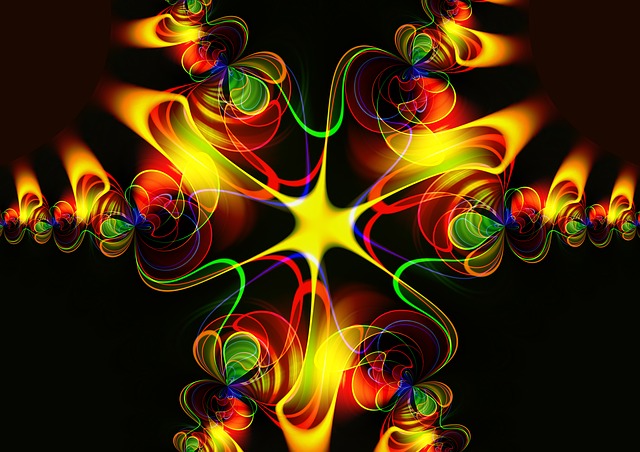
 rays, currently believed to emanate from cataclysmic stellar collapses, and Radio Sources, which are typically symmetric and seem associated with galactic cores, currently considered manifestations of space-time singularities or neutron stars. These two astrophysical phenomena appear distinct and unrelated, but they can be unified and explained using LTT effects. This article presents such a unified quantitative model. It will also show that the cognitive limitations to reality due to LTT effects can provide qualitative explanations for such cosmological features as the apparent expansion of the Universe and the Cosmic Microwave Background Radiation (CMBR). Both these phenomena can be understood as related to our perception of superluminal objects. It is the unification of these seemingly distinct phenomena at vastly different length and time scales, along with its conceptual simplicity, that we hold as the indicators of validity of this framework.
rays, currently believed to emanate from cataclysmic stellar collapses, and Radio Sources, which are typically symmetric and seem associated with galactic cores, currently considered manifestations of space-time singularities or neutron stars. These two astrophysical phenomena appear distinct and unrelated, but they can be unified and explained using LTT effects. This article presents such a unified quantitative model. It will also show that the cognitive limitations to reality due to LTT effects can provide qualitative explanations for such cosmological features as the apparent expansion of the Universe and the Cosmic Microwave Background Radiation (CMBR). Both these phenomena can be understood as related to our perception of superluminal objects. It is the unification of these seemingly distinct phenomena at vastly different length and time scales, along with its conceptual simplicity, that we hold as the indicators of validity of this framework. , and speed typically appears as
, and speed typically appears as  . The LTT effects, on the other hand, are first order in speed. The first order effects have been studied in the last fifty years in terms of the appearance of a relativistically moving extended body [7-15]. It has also been suggested that the relativistic Doppler effect can be considered the geometric mean [16] of more basic calculations. The current belief is that the first order effects are an optical illusion to be taken out of our perception of reality. Once these effects are taken out or ‘deconvolved’ from the observations, the ‘real’ space and time are assumed to obey SRT. Note that this assumption is impossible to verify because the deconvolution is an ill-posed problem – there are multiple solutions to the absolute reality that all result in the same perceptual picture. Not all the solutions obey SRT.
. The LTT effects, on the other hand, are first order in speed. The first order effects have been studied in the last fifty years in terms of the appearance of a relativistically moving extended body [7-15]. It has also been suggested that the relativistic Doppler effect can be considered the geometric mean [16] of more basic calculations. The current belief is that the first order effects are an optical illusion to be taken out of our perception of reality. Once these effects are taken out or ‘deconvolved’ from the observations, the ‘real’ space and time are assumed to obey SRT. Note that this assumption is impossible to verify because the deconvolution is an ill-posed problem – there are multiple solutions to the absolute reality that all result in the same perceptual picture. Not all the solutions obey SRT. (1)
(1) (2)
(2) . In other words, no object can appear to travel faster than the speed of light, entirely consistent with SRT.
. In other words, no object can appear to travel faster than the speed of light, entirely consistent with SRT.
 to
to  . This mapping is most obvious in its consequences. For instance, it takes an infinite amount of energy to accelerate an object to an apparent speed
. This mapping is most obvious in its consequences. For instance, it takes an infinite amount of energy to accelerate an object to an apparent speed 
 is related to the real time interval
is related to the real time interval  as:
as: (3)
(3) ). This observed time dilation is plotted in Fig. 1, where it is compared to the time dilation predicted in SR. Note that the time dilation due to LTT has a bigger magnitude than the one predicted in SR. However, the variation is similar, with both time dilations tending to
). This observed time dilation is plotted in Fig. 1, where it is compared to the time dilation predicted in SR. Note that the time dilation due to LTT has a bigger magnitude than the one predicted in SR. However, the variation is similar, with both time dilations tending to  as:
as: (4)
(4) . This equation also is plotted in Fig. 1. Note again that the LTT effects are stronger than the ones predicted in SRT.
. This equation also is plotted in Fig. 1. Note again that the LTT effects are stronger than the ones predicted in SRT.
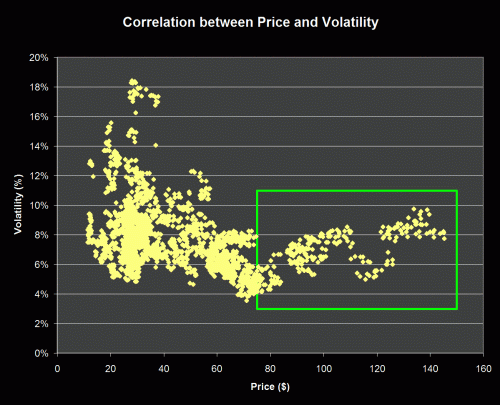
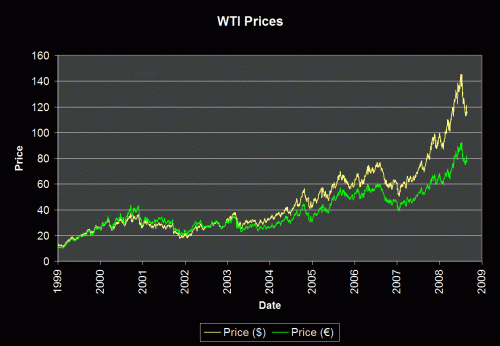
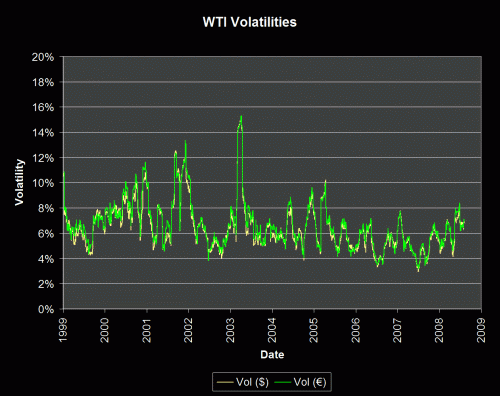
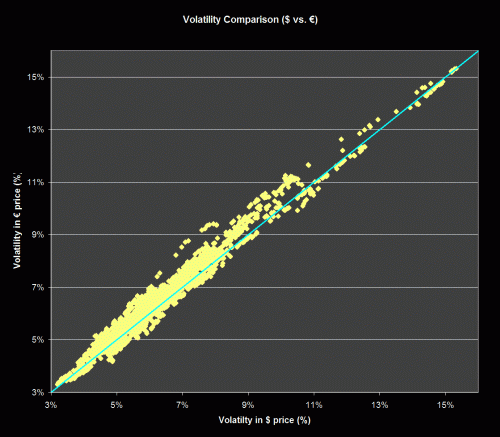
![sigma (t) = sqrt {frac{1}{{31}}sumlimits_{t - 15}^{t + 15} {left( {ln left[ {frac{{S(t)}}{{S(t - 1)}}} right] - mu } right)^2 frac{{252}}{{31}}} } sigma (t) = sqrt {frac{1}{{31}}sumlimits_{t - 15}^{t + 15} {left( {ln left[ {frac{{S(t)}}{{S(t - 1)}}} right] - mu } right)^2 frac{{252}}{{31}}} }](https://www.thulasidas.com/wp-content/uploads/easy-latex-cache/tex_101390ff297d43e0d3101c0ab20f1d1f.png)
